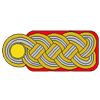
Hosted by Darren Baker
zimmerit
Biggles2

Joined: January 01, 2004
KitMaker: 7,600 posts
Armorama: 6,110 posts

Posted: Saturday, December 17, 2016 - 09:10 PM UTC
Found this interesting pic of a knocked out Tiger I Late. http://www.panzernet.net/panzernet/fotky/zimmerit/new03.jpg Note the big difference in pattern between the turret and hull. Some modellers have stated that the Dragon kit had wrong, or over-stated zim pattern on the turret, but this looks very similar. Also where the hit is. There's the zimmerit layer, a lighter area where there is no zimmerit, and finally a darker area around the penetration. If zimmerit was applied to a primed but unpainted surface, I would expect that exposed area to be a darker color(red oxide primer), and that the area surrounding the penetration to be lighter - bare metal. Judging from this photo, it looks like the zimmerit has been applied to a Dunklegelb painted surface as that exposed area is a similar B/W shade to other parts of the tank. Any opinions? 

Scarred

Joined: March 11, 2016
KitMaker: 1,792 posts
Armorama: 1,186 posts

Posted: Saturday, December 17, 2016 - 09:29 PM UTC
That lighter area could be the inner surface of the zimmerit, still bonded to armor after the toothed outer surface was destroyed/damaged. The dark ring around the impact crater could be primer exposed when the hit blew off all the zimmerit.

TopSmith

Joined: August 09, 2002
KitMaker: 1,742 posts
Armorama: 1,658 posts

Posted: Sunday, December 18, 2016 - 10:59 AM UTC
Patrick, I agree with your assessment.
Biggles, I agree that this is a fine example of the multi style Zimm some of the Tiger 1's had.
Biggles, I agree that this is a fine example of the multi style Zimm some of the Tiger 1's had.

GeraldOwens

Joined: March 30, 2006
KitMaker: 3,736 posts
Armorama: 3,697 posts

Posted: Monday, December 19, 2016 - 12:33 AM UTC
Zimmerit was applied in two layers on subsequent days, and force-dried using an alcohol torch. The first layer was applied to primed steel. Texture on the finish coat was supposed to be applied one ridge at a time, using a trowel, but Henschel speeded the process by using a metal comb on flat surfaces. Some tanks had this pattern on the turret sides as well, but others had the hand-applied pattern on the turret sides, as shown here. The ridges were more widely spaced, due to the limited time available
Other factories devised stamps or rollers to apply the texture more quickly to other types of AFV.
Other factories devised stamps or rollers to apply the texture more quickly to other types of AFV.
erichvon

Joined: January 17, 2006
KitMaker: 1,694 posts
Armorama: 1,584 posts

Posted: Monday, December 19, 2016 - 12:50 AM UTC
Another factor to consider is the German propensity for mix and match when repairing vehicles. It could be a turret off a Tiger that has had it's hull damaged beyond practical repair switched to a Tiger where the turret is FUBAR. All armies would try to salvage vehicles from the battlefield where possible for repair or at the very least for spare parts. The late war hybrid Tigers show this happening in factories so factory repairs doing said swaps is plausible as it's a lot quicker and cost effective than writing it off completely. They wouldn't chip off perfectly good zimmerit so that it matched the hull so it would be odd. Obviously their priority was to get vehicles back to the front where they were desperately needed. Just my thoughts on it.
 |






